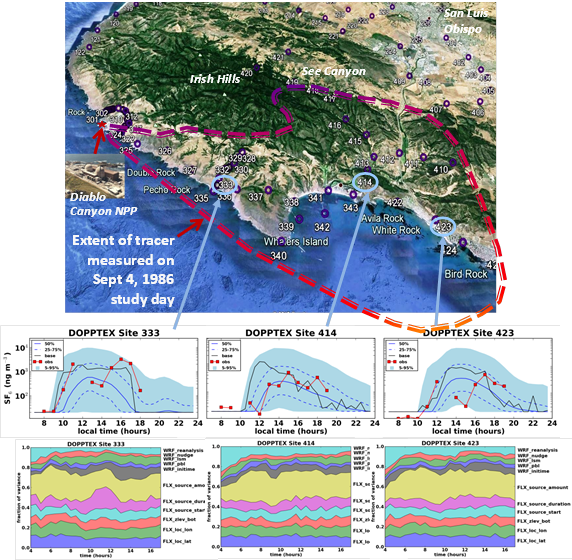Ronald Baskett (14-ERD-006)
Abstract
Accidental or terrorist releases of hazardous materials into the atmosphere can impact large populations and cause significant loss of life and/or property damage. Knowledge of the source properties for these releases is critical to understanding the event and predicting its consequences, yet this knowledge is often incomplete. We plan to address the need to reconstruct poorly characterized sources of atmospheric releases for events such as radioactivity released from the Fukushima Daiichi nuclear power plant in Japan in 2011, as well as for applications in attributing methane from landfills and wellheads. We will develop a Bayesian analysis system of statistical inference based on interpretation of probability to estimate source properties using available plume concentration or deposition measurements, in a way that accounts for prior uncertainties in the source properties, meteorological uncertainties, and unknown biases in models and observations. We will verify our capability against several key data sets.
We expect to develop a stand-alone set of computer scripts and codes that will provide an automated probabilistic estimate of the most likely source characteristics based on an ensemble of meteorological conditions. This project will address national needs in emergency response, counterterrorism, and attribution programs with an advanced capability to identify unknown sources of atmospheric plumes with quantified uncertainty. This capability will also be relevant for determining point-source emissions for international monitoring efforts such as for the Comprehensive Test-Ban Treaty Organization and for the Organization for Economic Cooperation and Development measurement of the long-range transport of air pollutants. It will enable source identification for odors or air pollutants, including methane leakage from wells used in hydraulic fracturing for release of oil or gas from rocks.
Mission Relevance
Our research in atmospheric source reconstruction is applicable to the monitoring, detection, analysis, and rapid response needs of multiple areas that have atmospheric components, including consequence management of nuclear power plant events, nuclear nonproliferation, nuclear forensics, and greenhouse gas and air-quality emission compliance in support of Laboratory missions in both national and energy security. The project is relevant to the Laboratory's core competency in earth and atmospheric science. Uncertainty quantification, model diagnosis and comparison, and managing large data sets aligns with the core competency in high-performance computing, simulation, and data science.
FY15 Accomplishments and Results
In FY15 we compared results from our ensemble simulations using the Weather Research and Forecasting Model, which is a next-generation mesoscale numerical weather prediction system, against the tracer data set for the Diablo Canyon Nuclear Power Plant near San Luis Obispo, California (see figure). In addition, we engaged a summer student to assist with testing our workflow system.
Publications and Presentations
- Baskett, R. L., et al., Estimating plume dispersion at PG&E's Diablo Canyon nuclear power plant with WRF-FLEXPART. (2015). LLNL-POST-677256.
- Lucas, D. D., et al., Impact of meteorological uncertainty on source estimation in complex coastal terrain. (2015). LLNL-PRES-672178.






